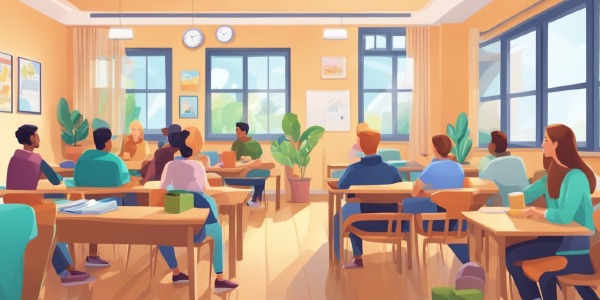Learning in a Multisensory World: Enhancing Education Through Sensory Integration Techniques
Engaging with your senses can enhance the way you learn. Multisensory learning taps into the combined power of seeing, hearing, movement, and touch to deepen understanding and retention of information.
This approach is based on the idea that the more senses involved in the learning process, the more robust the learning experience.

In education, sensory integration can be the key to unlocking potential in learners of all ages. It takes into account individual sensory preferences and tailors the educational experience to support these.
By incorporating techniques like visual aids, hands-on activities, and auditory stimulation, teachers can create a more dynamic and effective learning environment.
Key Takeaways
- Multisensory learning engages multiple senses to enhance education.
- Sensory integration in education is designed to support individual learning preferences.
- Incorporating various instructional strategies can make learning more dynamic.
Understanding Multisensory Learning

Multisensory learning harnesses the power of your sensory systems to boost cognition and perception. It integrates touch, sound, and sight to enhance your educational experiences.
The Science of Multisensory Integration
Multisensory integration refers to your brain’s ability to process and combine information from different sensory modalities. Neuroscience has shown that the multisensory brain can create more robust neural networks for learning.
For example, when you read aloud (combining sight and sound) instead of silently, you’re engaging multiple sensory systems, which can reinforce memory.
- Sight: Visual cues help you to identify and remember information.
- Sound: Auditory input can influence your ability to recall and understand concepts.
- Touch: Kinesthetic experiences support learning through doing.
Benefits of Multisensory Approaches
Adopting multisensory approaches in education has several advantages:
- Enhanced Attention: Engaging more than one sense can capture and maintain your attention better than a single sensory modality.
- Better Memory: Information presented in multiple ways is more likely to be retained.
- Increased Engagement: Learning becomes more interactive and enjoyable.
- Improved Sensory Regulation: It helps you regulate sensory input, which can be particularly beneficial if you have sensory integration challenges.
Challenges in Multisensory Education
Implementing multisensory education isn’t without its obstacles:
- Resource Intensiveness: It often requires more materials and planning.
- Training Requirements: Educators may need additional training to effectively deliver multisensory instruction.
- Individual Differences: Sensory processing varies from person to person, so what works for one may not work for another.
Sensory Systems and Learning
Your sensory systems play a vital role in how you perceive and interact with the world around you:
- Visual (Sight): You rely heavily on visual representations to form understandings.
- Auditory (Sound): Listening to explanations and sounds can enhance cognitive processes.
- Tactile (Touch): Hands-on activities can solidify knowledge and assist in concept mastery.
Sensory Integration in the Classroom

Integrating sensory methods into your teaching can transform the classroom into a dynamic learning environment. These techniques cater to diverse learning needs and leverage technology to make education more inclusive and effective.
Methodologies for Multisensory Teaching
In a multisensory classroom, you’ll find a variety of teaching strategies that engage more than one sense at a time. For example, a reading lesson might involve:
- Visual: Words and images on a screen or in a book.
- Auditory: Listening to recorded stories or reading aloud.
- Kinesthetic: Using finger-tracing of letters or words.
- Tactile: Handling objects that represent story elements.
These approaches benefit all students, especially those with learning differences like dyslexia, by providing multiple pathways to process and understand new information.
Technological Advances in Education
Education technology has introduced tools like virtual reality (VR) and multisensory learning stations that bring lessons to life. Here are some innovations:
- VR Headsets: These offer immersive experiences that enhance subjects such as history or science, making complex concepts easier to grasp.
- Interactive Whiteboards: They provide tactile engagement by allowing students to write and draw directly on a large screen.
- Sound-Field Systems: Amplifying a teacher’s voice across the classroom can aid students with sensory modulation challenges.
Inclusion and Accessibility
Your focus on inclusion means ensuring every student has access to learning materials. Techniques include:
- Adjustable Lighting: To accommodate those sensitive to bright lights.
- Text-to-Speech Software: This supports students who struggle with reading standard print.
- Customizable Learning Modules: Allow adaptation to different learning speeds and styles.
Multisensory Instructional Strategies

Multisensory instructional strategies enrich the learning environment by catering to the varied sensory preferences of students, which can enhance retention and engagement.
Designing Multisensory Lessons
When you design multisensory lessons, ensure that you’re considering all sensory modalities — visual, auditory, kinesthetic, and tactile.
For example, when teaching writing, you could integrate the sense of touch by using materials with different textures.
Your lesson plans should involve cognitive strategies that engage more than one sense at a time, providing empirical evidence of enhanced learning outcomes. Here’s a brief table to guide your planning:
| Sensory Modality | Teaching Tool Examples |
|---|---|
| Visual | Charts, diagrams, videos |
| Auditory | Songs, discussions, audio books |
| Kinesthetic | Role-playing, manipulatives |
| Tactile | Textured objects, sand trays |
Implementing Sensory Activities
When you’re implementing sensory activities, it’s crucial to create a range of experiences that appeal to your students.
For tactile stimulation, incorporate hands-on materials like clay for art or textured surfaces for touch-based projects.
This can be particularly effective for complex concepts, as the physical interaction with the educational content establishes stronger cognitive connections.
Evaluating Teaching Approaches
Finally, to ensure your teaching is effective, regularly evaluate your approaches.
Gather feedback from students and other stakeholders to see if the multisensory methods are meeting educational goals.
Use this information to refine your practices. Remember, the best teaching methods are often supported by empirical evidence, and you should adjust your strategies according to the data and student needs.
Technologies Enhancing Multisensory Learning

Multisensory learning harnesses the power of technology to create engaging and effective educational experiences. Through interactive tools and immersive environments, sensory integration is greatly enhanced in modern education.
Interactive Multisensory Resources
Interactive whiteboards and touchscreen displays stimulate tactile interaction with content, bridging the gap between you and the learning material.
Serious games blend fun with education, employing embodied interaction where your physical movements lead to on-screen actions, fully engaging multiple senses in the learning process.
For instance, science apps that simulate laboratory experiments not only display the procedure but also allow you to manipulate the virtual lab equipment. This provides real-time feedback and enhances your proprioceptive information about object shape and manipulation.
Leveraging Audio-Visual Materials
In today’s classroom, audio-visual materials are indispensable for presenting complex information in a digestible format.
Videos and animations enhance your perceptual learning, while podcasts and songs can make auditory learning more engaging.
- E-books with integrated audio: This technology brings together reading and listening, as the spoken word supports text comprehension.
- Closed-captioned and subtitled videos: These tools aid both audio and visual learning, ensuring that information is accessible to learners with differing sensory preferences.
Advances in Virtual and Augmented Reality
Virtual Reality (VR) and Augmented Reality (AR) are at the forefront of transformative educational experiences.
VR immerses you in a completely different environment, creating a sense of presence that can greatly enhance intersensory perception.
- AR apps: By overlaying digital information onto your physical environment, AR applications provide multisensory integration, merging real-world experience with enhanced data.
- VR simulations with force-feedback devices: These offer a rich learning environment where you can explore and interact with virtual objects, receiving tactile feedback that simulates real interaction, a critical component of immersive multisensory technologies.
Integrating Neuroscience and Education

In this section, you’ll discover how neuroscience can work with educational strategies to enhance the way students learn through their senses.
Brain Imaging and Learning Processes
Advancements in functional Magnetic Resonance Imaging (fMRI) have opened the door to observing your brain’s activity in real-time. This technology enables educators and researchers to see how multisensory learning can change neural patterns. For example, when you engage with both auditory and visual information, brain imaging can show increased connectivity between sensory areas, which is critical for effective learning processes.
Understanding Cognitive Mechanisms
The integration of sensory information is fundamental to cognition. Neuroscience helps in deciphering how different stimuli are encoded in your working memory. Knowing that, educators can tailor teaching methods to enhance cognitive mechanisms like attention and memorization. For instance, simultaneous visual and haptic input can accelerate the encoding of new information in primary school children.
Cross-Sensory Calibration and Perception
Cross-sensory calibration theory proposes that your senses fine-tune each other. When you learn, this calibration helps in forming a coherent perception from multisensory inputs. Studies in psychophysics and multisensory perception show that when sensory modalities are consistently paired, like sound and sight, your ability to process and understand the information improves.
Embodiment and Cognitive Development
Embodied cognition suggests that your physical interactions with the world are deeply connected to how you learn. Neuroscience reveals that engaging with different forms of haptic form information — the tactile feedback you receive from the environment — can significantly benefit your understanding of abstract concepts. This insight is particularly transformative for education, creating opportunities for a more hands-on, interactive learning environment that resonates with your cognitive development.
From Theory to Practice

To effectively incorporate multisensory learning into education, you need to bridge the gap from theoretical understanding to practical application. This involves designing inclusive curriculums, providing comprehensive training for educators, fostering community involvement, and tailoring the learning environment to support sensory integration.
Developing Effective Curriculums
When you are involved in curriculum development, it’s crucial to embed multisensory techniques into your lesson plans. A curriculum with multisensory integration might include:
- Auditory elements like music or spoken word for phonetic learning.
- Visual aids, such as charts and images to reinforce concepts.
- Tactile materials, like textured objects, to illustrate points in a tangible way.
- Kinesthetic activities that encourage students to learn through movement.
Remember to incorporate students’ prior knowledge and cater to different sensory processing needs to ensure that all learners benefit.
Training for Educators
Effective training for educators is important in equipping them with the skills needed for multisensory teaching approaches. Key components of this training should include:
- Understanding how sensory integration affects behavior and regulation.
- Strategies for identifying individual sensory needs in a diverse classroom.
- Techniques for adapting traditional teaching methods to be more multisensory.
Engaging in professional development can also help teachers integrate these approaches with confidence.
Engagement with Parents and Communities
Success in multisensory education often hinges on the support from parents and the wider community. You should:
- Communicate the benefits of multisensory learning to stakeholders effectively.
- Offer workshops for parents that explain how sensory integration supports their children’s education.
- Involve community members in providing resources for sensory-supportive experiences.
Through this engagement, a support network is built, reinforcing the value of sensory integration in learning.
Creating Sensory-Supportive Environments
A sensory-supportive environment is vital, whether that be in a traditional classroom or a space for infants. Your focus should be on:
- Classroom design that allows for different sensory zones equipped with appropriate stimuli.
- Elements such as lighting and color that influence sensory modulation.
- Flexible seating options to accommodate students’ varying sensory needs.
This attention to the environment helps students navigate their learning experiences more effectively and comfortably.
Future Directions and Research

In the rapidly evolving landscape of educational technology, your engagement with multisensory learning is critical. Future innovations will emerge from the integration of multidisciplinary studies, neuroscience’s insights on embodied cognition, and technology’s role in creating immersive learning environments.
Emerging Multisensory Research Fields
You’ll discover that neuroscience and embodied cognition are converging to form exciting new areas of study. This interdisciplinary research focuses on how sensory experiences can be integrated to enhance memory and learning processes. Researchers are particularly interested in how technology-enhanced learning can augment traditional educational methods. Notable areas include:
- Virtual Reality (VR) and Augmented Reality (AR), which create immersive educational scenarios that can adapt to your sensory input in real-time.
- Brain-computer interfaces that may allow direct interaction between your neurological activity and educational software, tailoring learning experiences uniquely to your neurological profile.
Building Prototypes and Testing Modules
The development of prototypes plays a pivotal role in translating research into tangible products. Here’s what you should know:
- Product Development: It’s about designing and refining multisensory modules until they’re ready for classroom use. This means balancing educational goals with the sensory experiences that promote them.
- Testing: Once prototypes are created, they require rigorous testing to ensure they’re both effective and enjoyable for you to use. Educational institutions and technology developers work together to assess their impact on learning outcomes.
Collaboration Among Stakeholders
Collaborations among various stakeholders are essential in advancing multisensory education. These partnerships bring together diverse expertise and perspectives, contributing to more holistic educational solutions. Here’s who you’ll be working with:
- Education Experts: To ensure that the multisensory products align with curricular standards and actually enhance learning.
- Researchers: Who provide the theoretical backbone, verifying that these products are grounded in solid neuroscience.
- Technology Developers: They turn ideas into practical tools, incorporating your feedback to iteratively improve the products.
- Community: Building partnerships with local communities to ensure that these solutions are accessible, effective, and meet real educational needs.
Conclusion

Integrating multisensory experiences into education is not just a beneficial approach; it’s a transformational one for your learning journey. Embracing multisensory learning strategies means bringing together sight, sound, touch, and movement to enrich the educational experience.
- Sensory Integration: By actively engaging multiple senses, you strengthen neural pathways, enhancing memory and understanding.
- Multisensory Techniques: Techniques such as using visual aids, hands-on activities, and auditory feedback can cater to diverse learning styles.
This approach fosters a more inclusive classroom where each student has the opportunity to thrive.
Remember, multisensory education isn’t a one-size-fits-all; it’s about tailoring the sensory experience to meet your unique learning needs.
To integrate these strategies:
- Identify your preferred learning channels.
- Seek out educational tools that stimulate those senses.
- Mix and match sensory inputs to find what works best for you.
By doing so, you’ll maximize the effectiveness of your study sessions and retain information more reliably.




